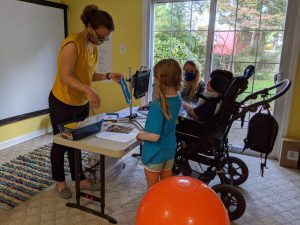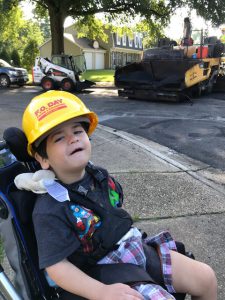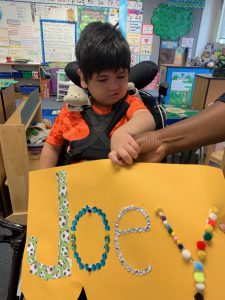 One aspect we needed to solve early on in our ALPS adventure was the physical setup.
One aspect we needed to solve early on in our ALPS adventure was the physical setup.
In transitioning from working one on one to working in a group with Joey, I was surprised at how Joey’s physical device itself interfered with connecting him with the whole group lessons.

 As our virtual learning school year has wrapped up in Northern Virginia, we are all left wondering what will be waiting for our students at the end of this summer “break”. The public schools are trying to figure out exactly how to walk the fine line between addressing a public health crisis while also maintaining high levels of instruction for children, and attempting to achieve programs that provide equity for all students. Truthfully, I am thankful I am not making the decisions. In the end, the decision made will inevitably leave many people frustrated. The truth is, there are no “right” decisions.
As our virtual learning school year has wrapped up in Northern Virginia, we are all left wondering what will be waiting for our students at the end of this summer “break”. The public schools are trying to figure out exactly how to walk the fine line between addressing a public health crisis while also maintaining high levels of instruction for children, and attempting to achieve programs that provide equity for all students. Truthfully, I am thankful I am not making the decisions. In the end, the decision made will inevitably leave many people frustrated. The truth is, there are no “right” decisions.  If I’m honest, I have to admit that I have had a hard time writing this blog post. It has been a week and a half since the last time I saw Joey, and I suspect I will not see him in person again for a long time. I miss him, and wish it was easier to work on his AAC communication on-line.
If I’m honest, I have to admit that I have had a hard time writing this blog post. It has been a week and a half since the last time I saw Joey, and I suspect I will not see him in person again for a long time. I miss him, and wish it was easier to work on his AAC communication on-line.  Joey continues to impress us with his strong visual memory. It seems as though I can introduce a sight word to him once, and he will soon be able to find it from a field of six. His ability to receptively identify these words in isolation continues to impress me. So we know he is able to recognize words. How do we get him from reading these words to reading and understanding what he reads? How do we measure that? How do we know when he is achieving it and it is time to increase the level of the work we give him?
Joey continues to impress us with his strong visual memory. It seems as though I can introduce a sight word to him once, and he will soon be able to find it from a field of six. His ability to receptively identify these words in isolation continues to impress me. So we know he is able to recognize words. How do we get him from reading these words to reading and understanding what he reads? How do we measure that? How do we know when he is achieving it and it is time to increase the level of the work we give him?
